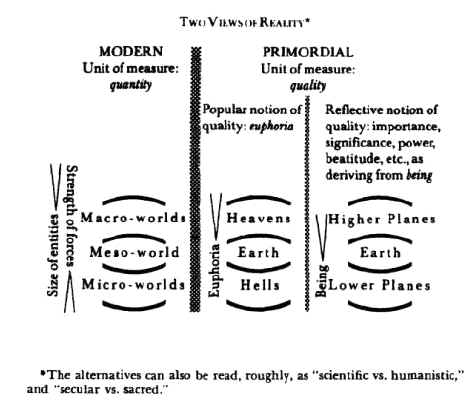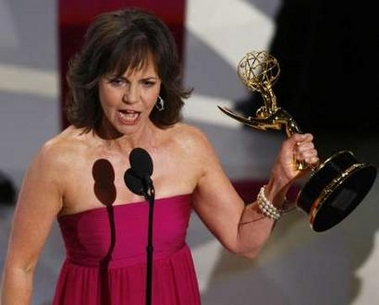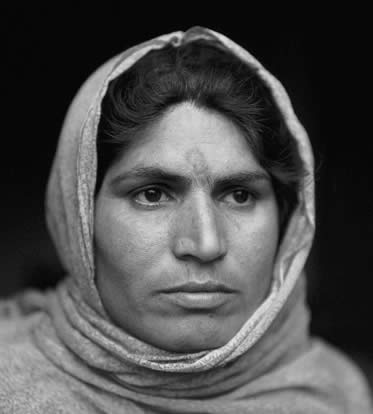James Baquet has a very interesting site – Take a look at Baquet’s site HERE It has a lot to say about Perennial Philosophy an the Primordial Tradition;
The modern popularity of the term can probably be attributed to the work of Aldous Huxley (1894-1963), who used the three words “The Perennial Philosophy” as the title of his erudite anthology of religious ideas. (See the Table of Contents here.) In defining the Perennial Philosophy in this book, Huxley doesn’t lay out the same four steps I described above; rather, he (fittingly) gives a more “esoteric” definition:
the metaphysic that recognizes a divine Reality substantial to the world of things and lives and minds; the psychology that finds in the soul something similar to, or even identical with, divine Reality; [and] the ethic that places man’s final end in the knowledge of the immanent and transcendent Ground of all being (vii)
(I discuss this definition, and the following one, more thoroughly in my article “This World and That“, in the section subtitled “Two Definitions of the Perennial Philosophy.”)
Closer to my formulation, but still not identical with it, is the definition he gives in his Introduction to the Bhagavad-Gita (as translated by Prabhavananda and Isherwood):
At the core of the Perennial Philosophy we find four fundamental doctrines.
- First: the phenomenal world of matter and of individualized consciousness–the world of things and animals and men and even gods–is the manifestation of a Divine Ground within which all partial realities have their being, and apart from which they would be non-existent.
- Second: human beings are capable not merely of knowing about the Divine Ground by inference; they can also realize its existence by a direct intuition, superior to discursive reasoning. This immediate knowledge unites the knower with that which is known.
- Third: man possesses a double nature, a phenomenal ego and an eternal Self, which is the inner man, the spirit, the spark of divinity within the soul. It is possible for a man, if he so desires, to identify himself with the spirit and therefore with the Divine Ground, which is of the same or like nature with the spirit.
- Fourth: man’s life on earth has only one end and purpose: to identify himself with his eternal Self and so to come to unitive knowledge of the Divine Ground.
(bullets added)
My four points are implicit in his, but I spell them out differently. As described here, they are quite similar, but Huxley’s 2 and 3 are reversed in comparison to mine.
Huston Smith
Huxley died (on the same day as JFK) in 1963. While he was still alive, another, younger, scholar was already making his mark on the “world religions” scene. Huston Smith, now in his late 80s (born 1919), has been both expounding and living the Perennial Philosophy for all of his adult life. (I had the pleasure of hearing Dr. Smith speak in 1997, before I went to Japan; someday I’ll post my notes from that afternoon.)
Dr. Smith uses the term “The Primordial Tradition” to discuss what I have been calling the Perennial Philosophy. He believes that, since “perennial” means “at all times,” it neglects the “everywhere” aspect of this philosophy. You can read more about this in this interview. In a nutshell, Dr. Smith says that the Primordial Tradition is both timeless and spaceless as well, “because it was not only always, but everywhere”–echoing Vincent of Lerins. The universe, he says, “fits into the primordial tradition but does not exhaust it. There are reaches beyond the physical.” He says that science is doing a fine job of learning about “the physical reaches of reality,” but that we are in danger of losing sight of the “other regions of reality which continue to exist whether we attend to them or not”–in other words, the “something bigger.”
He also noted that in writing his book The Religions of Man (now published as The World’s Religions), which focuses on what is different in the individual religions, he “became more and more struck by recurrent themes which seemed to surface just time and again like echoes.” Later, in another book entitled Forgotten Truth, he explored these “common denominators that ran through them all.”
Forgotten Truth examines our place in the various levels of the world around us. The modern view, Dr. Smith says, reflects the primordial, in that humans are in the center between a “world above” and a “world below.” Look at this chart, from page 4:
Dr. Smith’s footnote points out these parallels:

Modern=Scientific=Secular
Primordial=Humanistic=Sacred
In the Modern/Scientific/Secular view, humans occupy the “Meso-world,” between the larger (in simple terms, “galactic”) world above and the smaller (“microscopic”) world below. The Modern hierarchy is based on both size and the strength of the binding forces; these are measures of Quantity.
Both of the Primordial models, on the other hand, look to measures of Quality: in the popular notion, happiness or “Euphoria” is highest at the Heavenly level, and lowest in Hell; we on Earth are in between. The more sophisticated, “Reflective” Primordial view sees Being as the source of this hierarchy: the Higher Planes participate in Being in greater amounts; the Lower, in lesser. Again, Euphoria and Being are measures of the Quality, not Quantity, of things, and this emphasis on quality unites the Popular and Reflective worldviews.
This kind of connective thinking, seeing that worldviews have changed but that they are still based on hierarchies of Things Above and Below, will be returned to in the discussion of Neo-Perennialism below. But I offer them here as evidence of Dr. Smith’s deep thinking about how the Elementary idea (in Campbell/Bastian’s term) of Hierarchy has manifested itself various times, and even in different forms to the popular and reflective minds of the same era.
Ken Wilber
Reluctantly leaving Dr. Smith for now, we turn to an even more contemporary thinker, Ken Wilber (born 1949). Best known for his Buddhist and psychological writings, Wilber is also a proponent of Perennial themes. In the heart-rending story of his wife Treya’s battle with cancer, Grace and Grit, Wilber presents a long interview on his “Seven Points of Timeless Wisdom,” conducted by Treya before her death. You can read the full interview here; I will present only the Seven Points themselves:
- Spirit exists
- Spirit is found within
- Most of us don’t realize this Spirit within
- There is a way out
- The way leads to direct experience of Spirit
- This experience marks the end of sin and suffering
- Social action and compassion result
Looking again at my Four Points, we see these parallels:
| Neo-Perennialism |
Wilber |
| 1. There is something bigger than us |
1. Spirit* exists
2. Spirit is found within |
| 2. We either are (West) or seem to be (East) separated from it |
3. Most of us don’t realize this Spirit within |
| 3. Through various means we can become reunited with it (or realize that we already are) |
4. There is a way out
5. The way leads to direct experience of Spirit |
| 4. Once the separation is overcome, we will lead larger, richer, fuller lives |
6. This experience marks the end of sin and suffering
7. Social action and compassion result |
| *Wilber’s use of the word “spirit” leaps ahead and assigns a value to the “something bigger” in a way that my Point 1 does not. Needless to say, that this quality “is found within” is a further elaboration of something I am not yet willing to concede. This will become clearer in my discussion of Neo-Perennialism below. |
Again, a reading of the full interview will give you a better idea of Wilber’s thinking.
So this Perennial Philosophy (despite its immense implications) is a fairly simply idea to grasp. It reflects humankind’s universal impulse toward union with something bigger, which has been exercised in myriad ways throughout human existence. With that, I conclude my comments on the Perennial Philosophy itself.
Take a look at a range of materials on Baquet’s site HERE
—–0—–
NB All postings to this site relate to the central model in the PhD.
Summaries are HERE






 ‘Bush faces of the Dead – Source and a PoMo (Postmodern) primer
‘Bush faces of the Dead – Source and a PoMo (Postmodern) primer